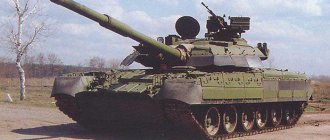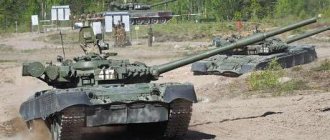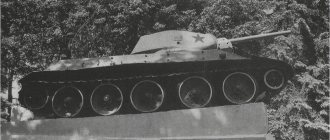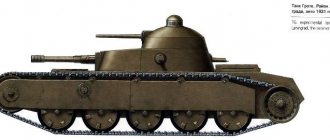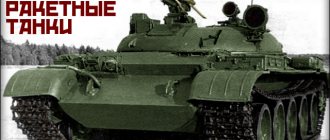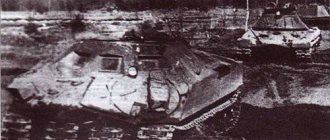The main tank T-72 was designed at the Uralvagonzavod design bureau (Nizhny Tagil) under the leadership of V.N. Venediktov in 1967-1973. A prototype of the tank, designated Object 172M, was manufactured at the end of 1970. The tank, designated T-72 "Ural", was put into service on August 7, 1973. During serial production in 1974-1996, Uralvagonzavod (Nizhny Tagil, 1974-1996 - 19973 units) and Chelyabinsk Tractor Plant (Chelyabinsk, 1978-1990 - 1874 units) produced 21,847 T tanks -72 all modifications. Since 1977, the tank was produced under license in Czechoslovakia (1977-1991 - 815 units), Poland (1979-1995 - 759 units), India (1988-2000 - 500 units), Iraq (100 pcs.), Iran (1993-2001 300 pcs.).
Description of the design of the T-72 "Ural" tank
The layout of the T-72 tank is classic, with the power compartment located aft. The tank's crew consisted of three people, located: the tank commander - in the turret to the right of the gun; driver - in the bow of the hull along the longitudinal axis; The gunner is in the turret to the left of the gun.
The tank hull is a rigid box welded from rolled armor plates. It consists of the bow, sides, stern, bottom, as well as fan and engine partitions and a roof over the power compartment.
The bow of the hull consists of upper and lower inclined armor plates, welded together, as well as with the front roof sheet, sides and bottom. The upper frontal sheet of the hull is inclined at an angle of 68° to the vertical and is a multi-layer combined barrier (steel-fiberglass-steel) with a thickness of 80+105+20=205 mm. The lower armor plate, 85 mm thick, is installed at an angle of 600. The sides of the hull are vertical armor plates 80 mm thick in the front and 70 mm in the rear. Turret protective strips are welded into the middle part of the sides to increase the internal volume of the hull and install the turret. The hull stern consists of a stern armor plate, a lower stern plate and gearbox housings. The hull roof consists of front and rear armor plates and inserts over the turret protective strips, welded to the hull, as well as a removable part. The bottom of the body is trough-shaped and consists of three stamped parts. To increase rigidity and place torsion bars in the bottom, longitudinal and transverse stampings are made. To protect the sides of the tank from cumulative weapons, 3 mm thick side screens made of aluminum alloy are designed. Four right and four left side screens are attached to the fenders and front flaps. In the combat position they rotate forward at an angle of 60°.
The tank turret is a shaped casting made of armored steel, to the top of which a roof is welded, as well as right and left heads for protecting the base tube of the rangefinder sight. The tower has a monolithic structure with variable wall thickness. The thickness of the frontal armor in the sector ±30° from the longitudinal axis of the tank is 400-410 mm with an inclination of 10-25°. The thickness of the sides ranges from 395-440 mm with tilt angles of 20-25°.
In front of the turret there is an embrasure for installing a cannon. To the right of the gun embrasure in the turret there is an embrasure for a coaxial machine gun. To the left of the gun embrasure a bracket for the night sight illuminator and a tube for supplying the electrical wire to it are welded. The tower is mounted on a ball support, the upper shoulder strap of which is connected to the bottom plate of the tower, and the lower shoulder strap is attached to the roof of the hull. The rotation of the tower is carried out using hydraulic and manual rotation mechanisms.
The tank's armament consists of one 125-mm smoothbore tank cannon D-81TM stabilized in two planes, one 12.7-mm NSV-12.7 machine gun mounted on a ZU-72 anti-aircraft gun (mounted on the commander's cupola shoulder strap), and 7. 62-mm PKT machine gun coaxial with a cannon. For aiming when firing from a cannon and coaxial machine gun, a monocular stereoscopic sight-rangefinder with independent stabilization of the field of view in the vertical plane TPD-2-49 and an electro-optical monocular periscopic night sight TPN-1-49-23 are used. For aiming when firing from an anti-aircraft machine gun, a K-10 collimator sight and a frame sight were used. Stabilization of the tank's armament is carried out by a two-plane electro-hydraulic stabilizer of tank armament 2E28M "Siren".
The gun is loaded by an electromechanical automatic loader of a cabinless type, with a capacity of 22 trays of shots. The tank's ammunition consists of 39 rounds of separate loading for the cannon, 300 rounds of ammunition for the anti-aircraft machine gun and 2,000 rounds of ammunition for the coaxial machine gun.
The power plant of the tank uses a 12-cylinder V-shaped four-stroke multi-fuel liquid-cooled diesel engine V-46 with a power of 780 hp. The tank's transmission is mechanical, with hydraulic control, and consists of a gearbox and two planetary gearboxes, structurally combined with final drives. Providing seven forward gears and one reverse gear.
The undercarriage, for one side, consists of six dual-slope rubber-coated track rollers, three single-pitch support rollers with internal shock absorption, one rear drive wheel with removable ring gears and one idler wheel with a crank track tensioning mechanism. The tank's suspension is individual torsion bar, with hydraulic shock absorbers on the 1st, 2nd and 6th road wheels. Tracks, 580 mm wide, fine-linked for 97 tracks, lantern engagement, with a rubber-metal (RMSh) or open (OMSh) hinge.
The electrical equipment is made according to a single-wire circuit (the emergency lighting and the OPVT pump-out pump are made according to a two-wire circuit). Voltage – 27 V (for starter circuit – 48 V).
To protect the tank crew from weapons of mass destruction, a collective protection system is used, consisting of: a GO-27 radiation and chemical reconnaissance device, ZETS11-3 equipment for controlling sealing actuators, a filter-ventilation unit (FVU), actuators, a ventilation valve and a ventilation hatch, and a pressure gauge. To extinguish a fire in the reserved volume of the tank, an automatic triple-action system UA PPO "Rosa-2" is used. To extinguish minor fires there is a manual carbon dioxide fire extinguisher OU-2. Thermal smoke equipment is used to set up a smoke screen.
Equipment for underwater driving of a tank (OPVT) is used for the tank to overcome water obstacles up to 5 m deep and up to 1000 m wide along the bottom. To open trenches and shelters, the tank is equipped with self-digging equipment located outside on the lower bow sheet of the hull. KMT-6 blade-action gauge trawls can be installed on some tanks.
To maintain external communications, the tank is equipped with an ultrashort wave radio station R-123M, and for internal communications - a tank intercom R-124.
Armament
The main gun was a 125 mm smoothbore gun D-81TM (2A46), which had a special design that allowed the barrel to be changed directly in the field without dismantling the gun itself. The ammunition was placed in different places. The carousel-type automatic loader contained 22 projectiles, and the remaining 23 projectiles were stored in non-mechanized ammunition racks of the hull and turret.
Additional armament consisted of two machine guns of different calibers. A 7.62 mm PKT machine gun with 2000 rounds of ammunition was coaxial with the cannon, and a 12.7 mm NSVT anti-aircraft machine gun was located on the roof of the turret and had 300 rounds of ammunition.
Later, smoke grenade launchers were added to the sides of the turret to independently create smoke screens.
Main modifications of the T-72 "Ural" tank
“Object 172” is an experimental medium tank designed at Uralvagonzavod under the leadership of L.N. Kartsev in 1967-1968. The first prototype of the tank was manufactured in the summer, the second in September 1968. Factory tests carried out until the end of 1968 showed insufficient reliability of the chassis, which led to its modification on the new experimental tank “Object 172M”. It was not put into service or into mass production.
The Object 172 tank differed from the T-64A:
– reinforced armoring of the frontal part of the turret without combined armor barriers; – electromechanical automatic loader of the cabless type with a capacity of 22 trays with shots. The tank's ammunition load was 39 rounds of separate loading for the cannon and 2,000 rounds of ammunition for the coaxial machine gun; – using a V-45K diesel engine with a power of 730 hp in the power plant.
“Object 173” is an experimental medium tank designed at Uralvagonzavod under the leadership of L.N. Kartsev in 1968. Two prototypes of the tank were manufactured in 1968 by converting from serial T-64A tanks. In the summer of 1969, comparative tests were carried out with the Object 172 and T-64A tanks. It was not put into service or into mass production. The only difference from the serial T-64A tank was the power plant and the fan cooling system.
“Object 172M” is an experimental medium tank designed at Uralvagonzavod under the leadership of N.V. Venediktov in 1969-1970. At the end of 1970, three prototypes of the tank were produced. In November 1970 - April 1971, the Object 172M tanks successfully passed factory tests. In the first half of 1973, 15 tanks of the pilot batch successfully passed military tests. Later it became the basis for the serial T-72 tank. The “Object 172” differed from the experimental tank in the installation of the V-46 engine with a power of 780 hp, the design of the air cleaner and chassis.
“Object 172M-2M” (theme “Buffalo”) is an experimental main tank designed at the Uralvagonzavod Design Bureau under the leadership of N.V. Venediktov in 1973-1974. In the first half of 1974, a prototype of the tank was manufactured. Passed factory tests in 1974-1975. It was not put into service or into mass production. The T-72 differed from the serial tank:
– Increasing the angle of inclination of the upper frontal part of the hull to 70 degrees and using combined armor barriers in the design of the frontal part of the turret. – Installation of an improved 125-mm D81TM cannon, characterized by higher accuracy, a TPD-K1 laser sight-rangefinder, a Buran-PA night passive-active sight, a Jasmine tank weapon stabilizer with an electric drive in the horizontal plane, an increase in ammunition to 45 rounds guns. – The power plant used a V-46F engine with a power of 840 hp. The fuel reserve has been increased, which has increased the range on one fill up to 1000 km. – Reinforced onboard planetary gearboxes were used in the power transmission. – An improved chassis with increased dynamic travel of the road wheels has been installed.
Read: Mi-8 transport and landing helicopter
T-72 "Ural" ("Object 172M") - a serial version of the tank "Object 172", manufactured at Uralvagonzavod (Nizhny Tagil) in 1974-1975 in the amount of 950 units. In 1975, the tank received its proper name “Ural”.
T-72 "Ural-1" ("Object 172M1") - an improved version of the serial tank "Object 172M", manufactured at Uralvagonzavod (Nizhny Tagil, 1975-1979 - 4727 units) and ChTZ (Chelyabinsk, 1978-1979 - 340 units) in 1975-1979 in the amount of 5067 units. It differed from the T-72 tank of the 1973 model:
– reinforced armor of the hull and turret; – since 1977, a cast turret with combined armor filled with sand cores was installed; – the gun is equipped with a heat-protective casing; – The L-2AG IR spotlight has been moved to the right cheekbone of the frontal part of the turret.
From 1975 to 1980, an export version of the tank was produced, designated T-72 (“Object 172M-E”). It was distinguished by the design of the armor protection of the frontal part of the turret, the PAZ system and the configuration of ammunition.
T-72K "Ural-K" ("Object 172MK") is a serial command tank designed at the Uralvagonzavod Design Bureau under the leadership of N.V. Venediktov based on the design of the serial T-72 tank in 1973. Serially produced at Uralvagonzavod (Nizhny Tagil) in 1974-1980. It differed from the T-72 linear tank by the installation of an additional short-wave radio station R-130M, navigation equipment TNA-3 "Kvadrat", an autonomous power supply unit AB-1, and a reduction in the cannon's ammunition load to 31 rounds.
T-72A (“Object 176”) is a serial main tank designed by the Uralvagonzavod design bureau under the leadership of N.V. Venediktov based on the design of the T-72 tank in 1979. The tank was put into service on June 22, 1979. During serial production at Uralvagonzavod (Nizhny Tagil - 7062 units) and ChTZ (Chelyabinsk - 680 units) in 1980-1984, 7742 T-72A tanks of all variants were produced.
It differed from the T-72 tank:
– reinforced armoring of the hull and turret; combined armor barriers made of sand rods were used in the frontal part of the turret, which received “cheekbone” protrusions; – installation of a 125-mm 2A46 cannon, which featured a smoother recoil when fired due to a fluid compensator in the recoil brake, which increased the accuracy and range of the shot; installation of a modernized 2A46M cannon since 1981. The gun's ammunition load was increased to 44 rounds; – installation of a laser sight-rangefinder TPD-K1 and an active-passive night sight TPN-3-49. Since 1982, the 1A40 sighting system has been installed on the tank, including the TPD-K1 laser sight-rangefinder; – improved V-shaped 12-cylinder diesel engine V-46-6 with a power of 780 hp. s., since 1984 a new V-84 engine with a power of 840 hp was installed. With. Since 1985, the tank has been equipped with a more efficient air cleaner and an intake air heating system (IAH); – installation of on-board solid rubber-metal anti-bulking screens; – since 1980, the 902A “Tucha” smoke grenade launch system and the “Sota” napalm protection system were installed.
In 1980, an export version of the T-72 tank was developed, designated T-72M. It was distinguished by monolithic armor of the hull and turret and the installation of an ESD instead of the SKZ. In 1982, based on the design of the T-72M tank, a modernized version was created - the T-72M1, which was distinguished by the use of combined armor barriers in the design of the frontal parts of the hull and turret, and the welding of a 16-mm armor plate to the upper part of the frontal part of the hull. Since 1985, the T-72A and T-72M1 tanks, respectively designated T-72AV and T-72M2, began to be equipped with a set of mounted dynamic protection.
T-72AK (“Object 176K”) is a serial command tank designed at the Uralvagonzavod Design Bureau under the leadership of N.V. Venediktov based on the design of the serial T-72A tank in 1979. Serially produced at Uralvagonzavod (Nizhny Tagil) in 1979-1984. It differed from the linear tank T-72A by installing an additional short-wave radio station R-130M, navigation equipment TNA-3 "Kvadrat", an autonomous power unit AB-1, and reducing the tank's ammunition load to 36 rounds for the gun.
T-72B (“Object 184”) is a serial main tank designed at the Uralvagonzavod design bureau under the leadership of N.V. Venediktov based on the design of the T-72A tank in 1981-1984. The tank was put into service on January 23, 1985. During serial production at Uralvagonzavod (Nizhny Tagil, 1985-1996 - 9425 units) and ChTZ (Chelyabinsk 1985-1990 - 850 units) in 1985-1996, 10275 T-72B tanks of all variants .
It differed from the T-72A tank:
– increasing the level of security (an additional 20-mm armor plate was welded to the upper part of the frontal part of the hull, a new turret with an increased package of combined armor barriers, a set of mounted dynamic protection “Contact” (227 containers) (in 1988, NDZ containers were installed on the tank turret in two tiers), a smoke screen system 902B “Cloud”, a napalm protection system “Soda” and high-speed fire-fighting equipment 3 ETs 13 “Rime”); – installation of a smooth-bore 125-mm gun-launcher 2A46M with a 9K120 “Svir” guided missile system and a two-plane stabilizer for tank weapons 2E42-2 “Jasmine” (vertical guidance stabilizer - electro-hydraulic, horizontal guidance - electric machine), sighting system 1A40-1 ( laser sight-rangefinder TPD-K1 and ballistic correction device), atmospheric conditions sensor DVE-BS with an interface unit (since 1991), sight-guidance device 1K13-49 (could be used as an active-passive night sight), increased to 45 shots ammunition for the gun; – using in the power plant a multi-fuel four-stroke high-speed liquid-cooled diesel engine V-84-1 with a power of 840 hp; – the tank is equipped with an auxiliary power unit; – using the Paragraph communications complex (ultra-short wave radio station R-173, radio receiver R-173P, a block of antenna filters and laryngophone amplifiers).
Some of the tanks, designated T-72B1 (“Object 184-1”), were produced without a guided missile system. Instead of the 1K13-49 sight-guidance device, these tanks were equipped with a TPN-3-49 night sight.
Since 1987, an export version of the T-72B tank began to be produced, designated T-72S, distinguished by the installation of the Kontakt dynamic protection kit for 155 containers. A version of the tank without a guided missile system was designated T-72S1. Since 1992, T-72S tanks began to be equipped with built-in dynamic protection for the hull and turret.
Since 1989, UVZ has produced tanks designated T-72B model 1989, with built-in Kontakt-5 dynamic protection for the hull and turret.
In 2000, the T-72BA tank (“Object 184A”), designed at UKBTM as part of the program of deep modernization of the T-72 tank in 1992-2000, was put into service. The modernization of T-72 tanks has been carried out during major overhauls at Uralvagonzavod since 1998 (in 1994-1997, no work was carried out on the modernization of the T-72 tank).
It differs from the T-72B tank:
– automated fire control system 1A-40-1M or 1A-40-M2, equipped with a digital tank ballistic computer on a microprocessor; – the power plant uses a multi-fuel four-stroke high-speed liquid-cooled diesel engine V-92S2 with a power of 1000 hp. and reinforced transmission; – automatic fire-fighting system ZETS13 “Iney” with two multiple actions; – the chassis is unified with that of the T-90A tank.
T-72B1 tanks undergo the same modernization, receiving the designation T-72BA1 (“Object 184A1”).
In 2006, UKBTM developed an option for modernizing the T-72B tanks, which received the designation T-72B2 “Slingshot” (“Object 184M”). It was planned to produce tanks from 2012 through modernization during a major overhaul at UVZ, but were later abandoned in favor of the T-72B3 project.
It differs from the T-72BA tank:
– installation on the hull and turret of a set of built-in dynamic protection “Relikt” and a system of electromagnetic protection of the tank against mines with a magnetic fuse, a complex of optical-electronic protection “Shtora-1”; – installation of a smooth-bore 125-mm cannon 2A46M-4 (M-5) with an optical-electronic device to improve firing accuracy, a multi-channel combined sight “Sosna-U” with a guided missile guidance channel, a block for correcting ballistic characteristics in the control system (sight-rangefinder TPD -K1 was left as a reserve), the ammunition included a high-power fragmentation-shrapnel and armor-piercing sub-caliber projectile with a core made of super-dense single-component and composite materials; – the introduction of the “Cape” camouflage kit and anti-cumulative lattice screens into the tank kit.
In 2011, UKBTM developed a modernization option for the T-72 tank, designated T-72B3. Since 2012, the tank has been supplied to the Russian Armed Forces (as of 2016, there are 800 tanks).
It differs from the T-72B2 tank:
– the gun’s ammunition included a shot with a 3BM-46 “Lead” sub-caliber anti-tank projectile with a 3BM-48 propellant charge; – a TKN-3MK tank commander’s sight with the “Double” system and a 2nd generation image intensifier was installed; – the power plant uses V-84-1 engines with a power of 840 hp. or V-92S2 with a power of 1000 hp; – an ultrashort wave radio station R-168-25U-2 “Aqueduct” with two transceivers was installed.
T-72BK (“Object 184K”) is a serial command tank designed by UKBTM (Nizhny Tagil) under the leadership of N.V. Venendiktov based on the design of the T-72B tank in 1987. The tank entered service in 1987. Serially produced until 1996 at Uralvagonzavod (Nizhny Tagil). It differed from the T-72B linear tank by the installation of an additional short-wave radio station R-130M, navigation equipment TNA-4, an autonomous power unit AB-1, and a reduction in the ammunition load for the gun.
Creation
The T-72 of the Cold War era was no exception to the rule and was created as a simple, reliable and unpretentious combat vehicle that can compete on equal terms with any other enemy tank. The fact that the MBT was a success is confirmed by the number of copies produced, which amounted to more than 30,000 and was second only to the T-54/55.
Initially, the Object 172 was created, which gradually developed into the Object 172M, which went into production under the name T-72. On August 7, 1973, it was adopted by the decision of the Central Committee of the CPSU and the Council of Ministers of the USSR, after which it was produced in our country from 1974 to 1992.
Combat use
The tank was first used in combat in 1982 in Lebanon, in the Bekaa Valley. Two Syrian tank brigades were surrounded and it was decided to send an elite brigade equipped with the new T-72 to help them. They successfully destroyed several Israeli M60s, suffering virtually no losses, thereby breaking through the encirclement.
In Iraq, Soviet vehicles performed even better, destroying Chieftains and Scorpions practically without worthy resistance, and in just 8 years of war, 60 tanks were lost.
But during the invasion of Kuwait, where Soviet MBTs were opposed by the new American Abrams M1A1, equipped with a 120 mm German cannon, up to 250 T-72s were lost. Moreover, there is a known case when an Abrams stuck in the mud was attacked by 3 T-72s, destroyed them, and was towed to the base, after which it returned to service.
This ratio of losses can be explained by the lack of modern shells capable of coping with the Abrams’ armor in Iraq.
In Georgia, Chechnya and Ossetia, T-72s again suffered heavy losses, and in Ossetia both sides of the conflict were armed with them, but Russia lost 2 tanks, and Georgia 18, which proves that all these losses occurred only due to poor training of the crews and improper command.
Indeed, during the assault on Grozny, tanks were used without shooter cover in urban conditions and were destroyed by shots to the sides and rear, while cases of penetration of the frontal armor are unknown.
Reliability on the march in mountainous conditions and the ability to withstand numerous hits without noticeable damage were noted.
Epilogue
Over the years, a lot of vehicles based on the T-72 have been created - various engineering vehicles, self-propelled guns, combat support vehicles and prototype tanks.
Having been put into service in 1973, the T-72 is now in service with many countries, and, thanks to modifications and modern equipment, it is capable of fighting equally with many other modern MBTs and will remain in the Russian army for a long time, even after the T-14 has entered it. Armata.
Its high mobility, firepower and protection, together with reliability, unpretentiousness and cost, are very successfully combined into one whole, which is appreciated by specialists around the world, many of whom rightfully consider the T-72 to be the best main battle tank of the second half of the 20th century.
Automatic loader for the 57 mm BMPT-72A cannon
Fig. 11. BMPT-72A automatic loader
Figure 11 shows one of the possible options for an automatic loader for 57 mm rounds. One of the main limitations when modeling an automatic loader is the height of the T-72 fighting compartment (if you look at photographs of the PT-76B with the Burevestnik BM - its turret is higher than the standard PT-76 turret with a 76-mm cannon), since the breech of the gun is C -60 is quite large and it is necessary to provide for its normal lowering down at the maximum gun elevation angle. The shot orientator is shown in blue - it is rigidly fixed in the turret and ensures transportation of the shot to the gun in any vertical position. Given the increased number of loading operations for the gun, its rate of fire is expected to drop to 100 rounds per minute.
Chassis and engine T-72B3
The model in question had its track tracks replaced. Compared to its predecessor, the new tank received running gear with a parallel hinge, which serves to improve performance and increase the service life. The transmission unit remained identical to the T-72 model.
The updated version is equipped with a more powerful multi-fuel power unit. Its power reaches 1130 horsepower. The engine allows the car to reach speeds of up to sixty kilometers per hour over rough terrain, and 70 km/h on the highway. Fully filling the fuel tanks is enough to cover a distance of half a thousand kilometers. The tank is quite capable of water obstacles up to 2.8 meters.
What did modernization give?
The conversion of serial T-72B tanks into a modernized version of the T-72B3 made it possible to enhance the combat potential of the vehicle. However, such a decision causes a lot of controversy and speculation. On the one hand, major repairs and partial improvements make it possible to strengthen the army at minimal cost. Another point of view is that it is ineffective and impractical to combine counterintuitive things, including a bolt-on optic cover and an open machine gun platform.
As a result, shortcomings can negate all objective advantages. It seems that the developers were simply trying to meet a certain budget, which is why they left so many “black holes”. In the meantime, we can only wait and believe that the designers will take into account all the mistakes and will be able to level them out in subsequent projects.
